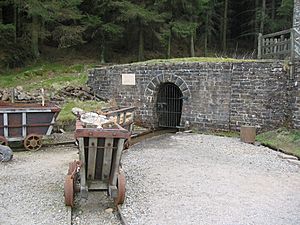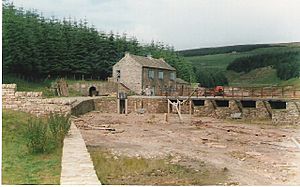North of England Lead Mining Museum facts for kids
The North of England Lead Mining Museum, often called Killhope, is a cool industrial museum. It's located near the village of Cowshill in County Durham, England. This museum is built on the site of an old mine called Park Level Mine. It shows what a lead mine was like in the 1800s.
Contents
Where is Killhope Located?
The museum is right next to the Killhope Burn, which is a small river. It's about 4 kilometers (2.5 miles) upstream from Cowshill. You can get there by taking the A689 road between Stanhope, County Durham and Alston, Cumbria.
A Special Natural Area
Killhope is in the middle of the North Pennines. This area is so beautiful and important that it's called an Area of Outstanding Natural Beauty. In 2003, it also became the first Geopark in Great Britain. This means the rocks and landscapes here are very special.
When Can You Visit?
The museum is open every day from April 1st to October 31st. It closes during the winter months because the weather can get very bad. However, groups can still visit if they book ahead. There's a bus service that goes through Weardale. It usually stops at Cowshill, but in summer, some buses will go all the way to Killhope if you ask.
The History of Lead Mining at Killhope
Lead ore is found in special rock veins within the Carboniferous rocks of the North Pennines. For a long time, people mostly dug for lead near the surface or by digging straight down.
Early Mining Operations
From 1818, a company called W B Lead Co controlled the mining here. This company was started by the Blacketts, a well-known family from Newcastle upon Tyne. They had rented the mining rights in Weardale from the Bishop of Durham.
In 1853, W B Lead started digging the Park Level Mine. This mine eventually connected with 11 different veins of lead ore. As the mine grew, so did the buildings on the surface.
Life at the Mine
In 1858, a "mineshop" was built. This was a place for the miners to stay. The area was very remote, so miners used to have a long walk to work every day. Having a mineshop made their lives much easier.
In 1862, storage areas called "bouse teams" were built. These held the raw lead ore, which was called "bouse." They also installed "washing rakes." These used water to separate the valuable lead ore from the waste rock.
The Killhope Wheel and Mine Closure
In 1878, the Park Level Mill started working. This happened soon after the mine found its richest lead veins. The mill helped speed up the process of washing the ore. The most important part of the mill was a huge waterwheel called the "Killhope Wheel."
However, not long after the mill opened, the price of lead dropped a lot. This made lead mining in Weardale too expensive to continue. In 1883, W B Lead closed all its mines in the area. Another company, Weardale Lead, took over the Park Level Mine. They kept it running until 1910, when production stopped. The mine briefly reopened in 1916 during the First World War, but then it was left empty for over 60 years. The buildings fell apart, and any useful equipment was taken for scrap.
How Much Lead Was Mined?
Between 1818 and 1883, records show that W B Lead took out over 31,200 tonnes of lead. From 1884 to 1916, Weardale Lead extracted another 9,000 tonnes. If you include the time before 1818, when there were no records, it's thought that Killhope might have produced over 60,000 tonnes of lead in total! Also, in the 1950s, about 180 tonnes of zinc were found by treating some of the waste material.
Bringing Killhope Back to Life
By 1980, the Killhope Wheel was almost going to be torn down. The washing area had turned into a swampy field, and the rest of the site was falling apart. That year, the Durham County Council took over the site. They started a project to restore it.
Restoration Milestones
The first building to be fixed was the "mineshop." It opened to the public in May 1984. The Killhope Wheel was repaired and working again by 1991. The mine itself opened for visitors in 1996.
The Artificial Mine Experience
At first, they hoped to fix the real mine so people could go inside. The Park Level was mostly in good shape, and the first 100 meters are used for access. However, the area near the first lead veins had collapsed and was unsafe.
So, they decided to build a new, "artificial" mine. This was done by digging a large chamber from the surface. Inside this artificial mine, the rock walls are actually made of fiberglass casts. These casts were taken from Killhope and from other mines in the Nenthead area of nearby Cumbria. Even though they are artificial, these casts look and feel exactly like real rock.
The Famous Killhope Wheel
One of the most impressive things at the museum is the Killhope Wheel. It's a huge metal waterwheel, 10 meters (about 33 feet) across! It was built by a company from Tyneside called William Armstrong. Other waterwheels were used at the mine, but this was the biggest. It was also the only one that survived after decades of being left alone. Now, it has been fully restored and works perfectly.
Awards and Recognition
The Killhope Museum has won several awards. In 2008, it was named the North East's Small Visitor Attraction of the Year. In 2004, it was the very first winner of the Guardian's Family-Friendly Museum award.
Other Lead Mining Sites Nearby
You can find other places that tell the story of lead mining in the area. These include the Heritage Centre at Allenheads in Northumberland. There's also the Nenthead Mines Heritage Centre, which is a short distance away in Cumbria.
Many signs of Weardale's lead mining past can still be seen today. The Durham Dales Centre in Stanhope even has guides for a "Lead Mining Trail." This trail takes you to many of the old mine sites that are easy to visit.
Here are some other old lead mines in County Durham:
- Low Slitt Mine, Westgate
- Middlehope Shield, Westgate
- Brandon Walls Mine, Rookhope
- Rookhope Old Smelt Mill
- Feldon Smelt Mill
- Coldberry Mine, Middleton-in-Teesdale
- Middle Greenlaws, Daddry Shield
- Derwent Lead Mines
- Lady Rake Mine, Harwood
- Greenhurth Mine, Harwood
- Pike Law Mines, Newbiggin, Teesdale
See Also
- Killhope




